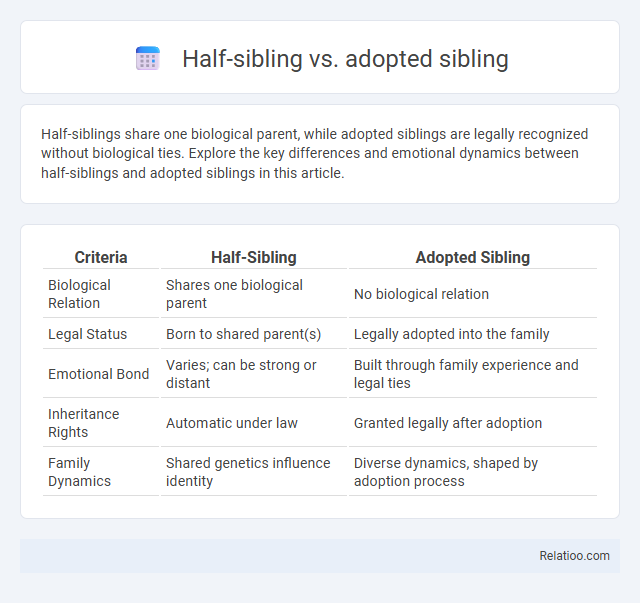Half-siblings share one biological parent, while adopted siblings are legally recognized without biological ties. Explore the key differences and emotional dynamics between half-siblings and adopted siblings in this article.
Table of Comparison
| Criteria | Half-Sibling | Adopted Sibling |
|---|---|---|
| Biological Relation | Shares one biological parent | No biological relation |
| Legal Status | Born to shared parent(s) | Legally adopted into the family |
| Emotional Bond | Varies; can be strong or distant | Built through family experience and legal ties |
| Inheritance Rights | Automatic under law | Granted legally after adoption |
| Family Dynamics | Shared genetics influence identity | Diverse dynamics, shaped by adoption process |
Understanding Half-Siblings and Adopted Siblings
Half-siblings share one biological parent, either a mother or father, creating a genetic link, while adopted siblings are legally recognized family members without a biological connection. Understanding these distinctions helps clarify family dynamics and inheritance rights, emphasizing that your relationship bonds extend beyond genetics through legal and emotional ties. Both half-siblings and adopted siblings contribute uniquely to your family structure and personal identity.
Biological Connections: Half-Siblings Explained
Half-siblings share one biological parent, either the mother or the father, creating a genetic link that is central to their familial relationship. Adopted siblings, however, do not share a biological connection but are legally recognized as family through adoption. Your understanding of half-sibling relationships emphasizes the importance of shared DNA in defining biological connections, distinguishing them clearly from adoption-based sibling ties.
Legal and Emotional Bonds in Adoption
Legal bonds between half-siblings and adopted siblings vary significantly; half-siblings share biological parents, granting inherent inheritance and custody rights, whereas adopted siblings gain legal recognition through formal adoption processes, securing parental rights and responsibilities. Emotional bonds in adoption can be as strong as biological connections, influenced by shared experiences and family environment rather than genetics alone. Understanding these distinctions helps clarify rights, responsibilities, and emotional dynamics within blended or adoptive families.
Family Dynamics: Similarities and Differences
Half-siblings share one biological parent, influencing their genetic ties and family roles differently than adopted siblings, who share no biological connection but often develop strong emotional bonds through shared upbringing. Family dynamics among half-siblings often involve navigating complexities related to inheritance and parental attention, whereas adopted siblings may face identity and belonging challenges while building familial trust. Both relationships contribute uniquely to sibling bonds, blending nature and nurture in diverse family structures.
Social Perceptions and Stereotypes
Social perceptions often distinguish half-siblings as biologically linked yet sometimes considered less "close" than full siblings, whereas adopted siblings may face stereotypes questioning the authenticity of their familial bond. Society tends to idealize genetic connections, causing your relationships with half-siblings to be viewed through the lens of shared DNA, while adopted siblings confront challenges in acceptance despite equal emotional ties. These stereotypes impact family dynamics and influence how siblings relate and are perceived within broader social contexts.
Inheritance and Legal Rights
Inheritance laws treat half-siblings, adopted siblings, and full siblings differently based on legal recognition and familial relationships. Half-siblings share one biological parent, granting them inheritance rights similar to full siblings in many jurisdictions, while adopted siblings have equal legal rights to inheritance as biological siblings once formal adoption is established. Understanding your specific state or country's laws is crucial, as these distinctions affect your legal rights and inheritance claims.
Cultural Perspectives on Sibling Relationships
Cultural perspectives on sibling relationships vary significantly between half-siblings, adopted siblings, and full siblings, influencing familial bonds and social roles. In many cultures, half-siblings may be seen as less connected due to differing parental lineage, while adopted siblings often experience dynamic acceptance depending on societal attitudes towards adoption and chosen kinship. These cultural interpretations shape expectations of loyalty, inheritance rights, and emotional closeness, impacting the social fabric of sibling ties across diverse communities.
Navigating Identity and Belonging
Navigating identity and belonging among half-siblings, adopted siblings, and full siblings involves understanding the unique family dynamics and emotional bonds in each relationship. Your sense of connection may differ based on shared genetics, shared experiences, or legal ties, which influence how identity and belonging are formed and maintained. Recognizing these distinctions helps foster empathy and strengthens relationships within diverse family structures.
Supporting Healthy Sibling Relationships
Supporting healthy sibling relationships requires understanding the unique dynamics between half-siblings, adopted siblings, and full siblings, each shaped by genetic, emotional, and legal factors. Your approach can foster bonding by promoting open communication, respect for individual identities, and shared experiences that build trust and empathy regardless of biological ties. Establishing consistent family routines and encouraging inclusive activities help nurture a supportive environment where all siblings feel valued and connected.
Choosing the Right Terminology
Choosing the right terminology for sibling relationships is crucial for clarity and accuracy. Half-siblings share one biological parent, distinguishing their genetic connection, while adopted siblings are legally recognized without biological ties, emphasizing the importance of legal and emotional bonds. Your choice of terms should reflect both the biological reality and the legal or emotional context to ensure respectful and precise communication.

Infographic: Half-sibling vs Adopted sibling
 relatioo.com
relatioo.com